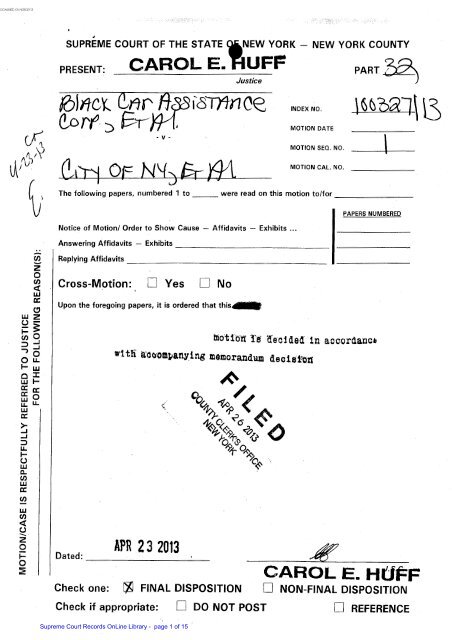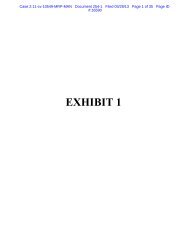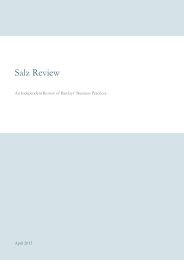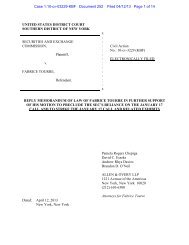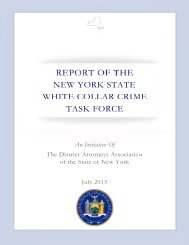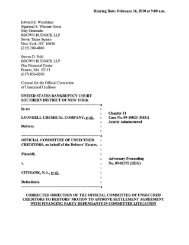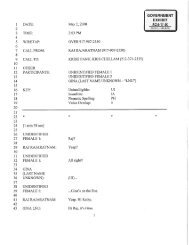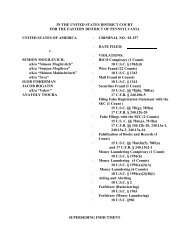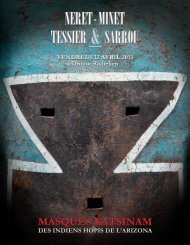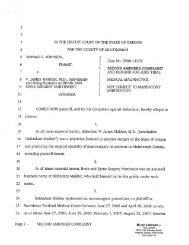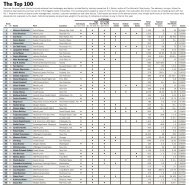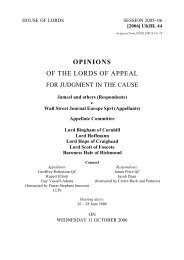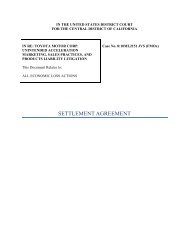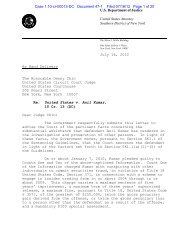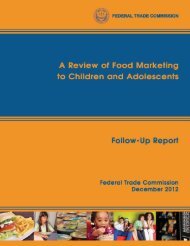CA L E.BuFF
CA L E.BuFF
CA L E.BuFF
You also want an ePaper? Increase the reach of your titles
YUMPU automatically turns print PDFs into web optimized ePapers that Google loves.
S<strong>CA</strong>NNED ON412612013<br />
SUPREME COURT OF THE STATE<br />
NEW YORK - NEW YORK COUNTY<br />
PRESENT: <strong>CA</strong> L E.<strong>BuFF</strong> PART LT<br />
Justice<br />
-v-<br />
MOTION SEQ. NO.<br />
MOTION <strong>CA</strong>L. NO.<br />
The following papers, numbered 1 to<br />
were read on this motion to/for<br />
-..<br />
v)<br />
CI<br />
z<br />
0<br />
2<br />
W<br />
K<br />
Notice of Motion/ Order to Show Cause - Affidavits - Exhibits ...<br />
Answering Affidavits - Exhibits<br />
Replying Affidavits<br />
Cross-Motion: 0 Yes 0 No<br />
Upon the foregoing papers, it is ordered that this<br />
I<br />
PAPERS NUMBERED<br />
APR 23 2013<br />
Supreme Court Records OnLine Library - page 1 of 15
SUPREME COURT OF THE STATE OF NEW YORK<br />
COUNTY OF NEW YORK: PART 32<br />
BLACK <strong>CA</strong>R ASSISTANCE CORPORATION,<br />
THE LIVERY ROUND TABLE, INC., DIAL 7 <strong>CA</strong>R &<br />
LIMOUSINE SERVICE, INC., DIAL <strong>CA</strong>R, INC.,<br />
ELITE LIMOUSINE PLUS, INC., FAST OPERATING<br />
CORP., DBA <strong>CA</strong>MEL <strong>CA</strong>R AND LIMOUSINE<br />
SERVICE, INTA-BORO ACRES, INC., LOVE<br />
CORPORATE <strong>CA</strong>R INC., ROYAL DISPATCH<br />
SERVICES, INC., VITAL TRANSPORTATION, INC.,<br />
ARTHUR HARRIS, and ALEXANDER REYF,<br />
Index No. 100327/13<br />
Petitioners, :<br />
- against -<br />
THE CITY OF NEW YORK;<br />
MICHAEL R. BLOOMBERG, in his official capacity as<br />
Mayor of New York City; the NEW YORK CITY TAXI<br />
& LIMOUSINE COMMISSION, a charter-mandated<br />
agency; and DAVID YASSKY, in his official capacity as<br />
Chairman and Commissioner of the New York City Taxi<br />
Sr L i MO us i nc Coni ni i ss i o 11,<br />
:<br />
:<br />
Respondents. :<br />
<strong>CA</strong>ROL E. HUFF, J.:<br />
In this Article 78 proceeding, petitioners seek to enjoin implementation of a proposed “ehail”<br />
pilot program for medallion taxis.<br />
The twelve-month e-hail program (the “Program”) would enable passengers who have an<br />
app on their smartphone to communicate with a medallion taxi to request a pickup. The taxi<br />
driver, who would have a corresponding device and app, would confirm the request, indicate that<br />
the taxi is “off-duty’’ and procecd to pick up the passenger.<br />
As stated in the Resolution Approving a Pilot Program to Evaluate Electronic Hail<br />
Supreme Court Records OnLine Library - page 2 of 15
Applications (“Program Resolution”), adopted by respondent New York City Taxi and<br />
Limousine Commission (“TLC”) on December 13,2012, the Program would last for twelve<br />
months, app providers would be subject to the approval of the TLC, and fares could be paid<br />
electronically through the e-hail app. The Program would be restricted in Manhattan south of<br />
59“’ Street to a half-mile pickup range, and elsewhere to a mile and a half. Certain areas, such as<br />
airports and places with provisions for taxi lines, would be excepted; e-hail requests must not<br />
disclose the passenger’s desired destination or other information about the passenger; and<br />
authorized apps must allow for “one-touch” acceptance of e-hails by the taxi driver. All licensed<br />
taxi drivers in the city are eligible to participate in the Program, but participation is optional.<br />
Petitioners are, with one exception (Arthur Harris, an elderly person who does not own a<br />
smartphone), entities that represent or have financial interests in businesses that operate vehicles<br />
known as black cars or livery or for-hire cars (collectively, “black cars”). Black cars are<br />
distinguished from yellow medallion taxis in that, at least generally, they can be summoned by<br />
pre-arrangement through electronic communication devices (including phones, radios and,<br />
notably, apps for e-hailing), while taxis are procured by street hails. Petitioners contend that the<br />
Program will impermissibly blur the distinction between black cars and taxis deliberately set by<br />
legislative action.<br />
Petitioners allege seven causes of action: First, that the Program violates New York City<br />
Administrative Code $ 19-511 (a), which requires licenses for communications systems used for<br />
arranging pickups; second, that the Program violates NYC Admin. Code 9 19-507(a)(2), which<br />
prohibits drivers from refusing to pick up passengers without justifiable grounds; third, that the<br />
Program is not a permissible pilot program as provided for in NY City Charter 6 2303; fourth,<br />
-2-<br />
Supreme Court Records OnLine Library - page 3 of 15
that respondents failed to follow procedures required for rules changes pursuant to the New York<br />
City Administrative Procedure Act; fifth, that the TLC failed to follow its own rules for<br />
implementing pilot programs; sixth, that the Program violates the State Environmental Quality<br />
Review Act (SEQRA, 6 NYCRR 8 617) and the City Environmental Quality Review rules<br />
(CEQR, 62 RCNY 8 5-01 et seq.), because the TLC failed to perform a review of the Program’s<br />
potential environmental impacts; and seventh, that the Program violates New York City Human<br />
Rights Law 5 8-107(4) because it will have a disparate, discriminatory impact on the elderly.<br />
By order dated April 8,2013, Metropolitan Taxicab Board of Trade was given leave to<br />
intervene as a respondent.<br />
This proceeding, brought pursuant to CPLR 7801 and 7803(3), is in the nature of<br />
mandamus to review. See Scherbyn v Wayne-Finger Lakes Bd. of Co-op. Educ. Serv., 77 NY2d<br />
753, 757-78 (1991) (citations omitted):<br />
In a proceeding in the nature of mandamus to review . . . a court examines an<br />
administrative action involving the exercise of discretion. . . . [N]o quasi-judicial<br />
hearing is required; the petitioner need only be given an opportunity “to be heard”<br />
and to submit whatever evidence he or she chooses and the agency may consider<br />
whatever evidence is at hand, whether obtained through a hearing or otherwise.<br />
The standard of review in such a proceeding is whether the agency determination<br />
was arbitrary and capricious or affected by an error of law.<br />
A threshold issue is petitioners’ claim that the Program is merely a “faux” pilot program<br />
not authorized by the Charter. In their third cause of action petitioners contend that respondents<br />
acted beyond their powers in implementing the Program. The Charter provides: “The<br />
jurisdiction, powers and duties of the [TLC] shall include the regulation and supervision of the<br />
business and industry of transportation of persons by licensed vehicles for hire in the city,<br />
pursuant to provisions of this chapter.” NY City Charter 5 2303(a).<br />
-3-<br />
Supreme Court Records OnLine Library - page 4 of 15
Such regulation and supervision shall extend to: . , . The development and<br />
effectuation of a broad public policy of transportation affected by this chapter as<br />
it relates to forms of public transportation in the city, including innovation and<br />
experimentation in relation to type and design of equipment, modes of service and<br />
manner of operation, which for limited purposes and limited periods of time may<br />
depart from the requirements otherwise established for licensed vehicles pursuant<br />
to this chapter.<br />
NY City Charter § 2303(b)(9).<br />
Title 35 of the Rules of the City of New York (“RCNY”) contains rules applicable to the<br />
TLC. 35 RCNY 5 52-21(a) affirms that “experimentation through pilot programs [authorized by<br />
the Charter] may, for limited purposes and limited periods of time, depart from the requirements<br />
established in these Rules.”<br />
Petitioners focus on the requirement for “limited purposes and limited periods of time” in<br />
defining a pilot program, arguing that the Program has neither.<br />
In contending that the Program is not time-limited, petitioners assert that effectively it is<br />
an implementation that cannot be reversed once in place. They argue that the TLC, after it<br />
withdrew contested proposed rule changes that would have implemented a permanent program,<br />
then proposed the experimental Program as a way to get around the process for rules changes.<br />
However, the Program’s twelve-month time limitation clearly constitutes a “limited period.”<br />
When the period is over, neither the TLC nor any other respondent can install the Program<br />
permanently by fiat, but still must hold hearings and adhere to other rules changing procedures.<br />
That an e-hail system might eventually be permanently implemented because the Program<br />
proved to be popular, effective and lawful is not a valid argument against it. Petitioners do not<br />
dispute that the TLC has implemented other pilot programs for as long as thirteen months<br />
without challenge.<br />
Ashwini Chhabra 2/22/13 Aff., 7 44. In Samuelson v Yasskv, 29 Misc3d<br />
-4-<br />
Supreme Court Records OnLine Library - page 5 of 15
840 (Sup Ct, NY County 2010), cited by petitioners in connection with the “limited purposes”<br />
prong of the Charter provision, the court approved a twelve-month pilot program.<br />
With respect to “limited purposes,” petitioners argue that the Program is unlimited in that<br />
it is open to every licensed taxi driver in the city, every passenger in the city, and virtually every<br />
geographical area of the city. They cite Samuelson, supra, favorably as the only published case<br />
applying NY City Charter 8 2303(b)(9), because the court upheld a program that was limited to<br />
five former bus routes. (The court did not specifically address the meaning of “limited<br />
purposes,” and neither does the legislative history.) Petitioners, however, are confusing<br />
“purposes” and “extent.” The extent of the Program is city-wide, but its purpose is to<br />
“test and evaluate smartphoiie electronic hail applications that can be used to request taxicab<br />
service.” Program Resolution at 1. The purpose is limited in that it contains nothing permanent<br />
or mandatory. Any experiment to determine whether an e-hail program will work in New York<br />
City would require extensive participation to determine, for example, effects on street-hail<br />
availability and whether there would be sufficient numbers of participating taxi drivers to meet<br />
demand.<br />
For these reasons, TLC’s designation of the Program as a “pilot program” within the<br />
nieaning of the Charter and RCNY is upheld. Accordingly, petitioners’ third cause of action is<br />
denied.<br />
In their first cause of action petitioners contend that the Program violates NYC Admin.<br />
Code Q 19-511 (a) in that it does not license app providers, which are analogous to base station<br />
operators. Section 19-51 l(a) provides: “The commission shall require licenses for the operation<br />
of two-way radio or other communications systems used for dispatching or conveying<br />
-5-<br />
Supreme Court Records OnLine Library - page 6 of 15
information to drivers of licensed vehicles . . . and shall require licenses for base stations, upon<br />
such terms as it deems advisable. . . .” (Petitioners approvingly cite a TLC ruling that a license<br />
for a base station satisfies the licensing requirement for an e-hail “communications system.”<br />
Reply Memorandum of Law at 8, n 6; TLC Industry Notice #I 1-16, July 18,201 1.)<br />
This provision of the New York City Administrative Code is not per se one of the rules<br />
from which respondents may “depart from” pursuant to NY City Charter tj 2303(a) (“may depart<br />
fi-om the requirements otherwise established . . . pursuant to this chapter) or 3.5 RCNY S 52-<br />
2 1 (a) (may “depart from the requirements established in these Rules”) (emphases added).<br />
However, the TLC has been given the authority to issue and set the conditions of licenses (9 19-<br />
5 1 1 [a], supra “[upon such terms as it deems advisable”]; 35 RCNY 4 52-03) and it has done so<br />
with respect to base station operators, for example, in 35 RCNY 0 59B-04 et seq. Thus, the<br />
Administrative Code requires the TLC to issue licenses, a requirement which may not be waived,<br />
but the TLC sets the license conditions, which may be “departed from.”<br />
In the Program the TLC proposes to issue temporary “authorizations” pursuant to a<br />
thirty-two page Memorandum of Understanding (“MOU”) that repeats many of the requirements<br />
(such as insurance and bonding) for a license, but differs in certain respects including as to term.<br />
The renewable term for a base station license is three years (3.5 RCNY tj .59B-O6[a][ l]), while<br />
the MOU authorization is for one year only and is teiminable by the TLC without cause.<br />
To compel the TLC to issue licenses for a full three years would be to defeat the purpose<br />
of an otherwise lawful pilot program, and, indeed, lend support to petitioners’ own argument that<br />
the Program was intended to be permanent. The use of the term 44authorization” in the MOU<br />
rather than “license,” so as to avoid confusion as to what the MOU was granting, is a negligible<br />
-6-<br />
Supreme Court Records OnLine Library - page 7 of 15
difference that is not sufficient to defeat the Program. Here, the authorization functions as a<br />
temporary, limited license, which of course is appropriate for a pilot program. Accordingly,<br />
petitioners’ first cause of action fails.<br />
And also, accordingly, respondents are permitted temporarily to waive the provision of<br />
35 RCNY tj 54-14 prohibiting the use of electronic devices while operating vehicles, since the<br />
rule is one that TLC may “depart” from in a pilot program.<br />
35 RCNY 9 52-21(a), supra.<br />
Petitioners complain that taxi drivers’ use of the “one touch” e-hail system will distract them and<br />
cause accidents, but neglect to point out that their own drivers are permitted to use such devices<br />
already, in addition to phones and two-way radios.<br />
In their second cause of action petitioners contend that the Program violates NYC<br />
Admin. Code 5 19-507(a)(2), which prohibits drivers from refusing “without justifiable grounds,<br />
to take any passenger or prospective passenger to any destination within the city.” Petitioners<br />
argue that because a driver is free to accept or not accept an e-hail notification on the driver’s<br />
smartphone, he or she can be selective about which passengers to pick up. Also, they argue that<br />
the driver can cancel an e-hail acceptance upon seeing the prospective passenger or upon seeing<br />
a “more attractive-looking’’ passenger.<br />
In fact, at least on its face, the Program appears better aimed at avoiding discriminatory<br />
passenger selection. The driver must accept an e-hail without knowing the passenger’s identity<br />
or destination. If the driver cancels the acceptance, the incident has been recorded so that a<br />
potential passenger complaint can be better investigated. In any event, one of the purposes of a<br />
pilot program such as this is to determine in real-world conditions whether discriminatory<br />
passenger selection will increase, decrease or remain the same under an e-hail program.<br />
-7-<br />
Supreme Court Records OnLine Library - page 8 of 15
Accordingly, the second cause of action is denied<br />
In their fourth cause of action petitioners contend respondents violated Chapter 45 of the<br />
New York City Charter, the City Administrative Procedure Act (“<strong>CA</strong>PA”). NY City Charter 6<br />
1043 provides, “No agency shall adopt a rule except pursuant to this section,” which prescribes<br />
procedures for such adoptions.<br />
This Court has already found that the Program is a valid pilot program. Such programs<br />
do not require “rule” changes to be put into effect because 35 RCNY 5 52-21(a) authorizes<br />
departures from rules. Petitioners’ citation of Sinnh v Taxi & Limousine Commn., 282 AD2d<br />
368 (1‘‘ Dept 2001) does not alter the extension of that finding to this cause of action. In Singh,<br />
the TLC sought to shorten the grace period for the renewal of an operator’s license from six<br />
months to thirty days after the license expired. The court found: “The policy change, which<br />
materially affected the rights of all such licensees equally and without exception, effectively<br />
amounted to the adoption of a new ‘rule.”’ See also Miah v Taxi & Limousine Commn., 306<br />
AD2d 203 (1” Dept 2001) (policy was deemed a rule when it “was intended to be applied<br />
generally to all cab drivers seeking renewal of their taxi drivers’ licenses, without regard to<br />
individual circumstances or mitigating factors, and it is indisputable that it materially affected<br />
the rights of all such licensees equally and without exception.”) The Program, which is limited<br />
in time and in which drivers participate at their own option, does not fall within these definitions<br />
of “rule.” Accordingly, the fourth cause of action is denied.<br />
In their fifth cause of action petitioners contend that respondents acted arbitrarily and<br />
capriciously in failing to comply with TLC procedures for initiating pilot programs. (After this<br />
proceeding commenced, the TLC amended the Program Resolution in response to several of<br />
-8-<br />
Supreme Court Records OnLine Library - page 9 of 15
petitioners’ objections in connection with these procedures.) With respect to pilot program<br />
proposals, 35 RCNY !-j 52-24 et seq establishes guidelines aimed at ensuring the thoroughness of<br />
the subniission and of its review. Respondents counter that, since the TLC itself originated the<br />
proposal, the proposal was sufficiently well known to satisfy the purpose of these guidelines.<br />
An administrative agency, “acting pursuant to its authority and within the orbit of its<br />
expertise, is entitled to deference . . . ” Partnership 92 LP & Bld. Mgt. Co. Vv State of N.Y. Div.<br />
of Hous. & Community Renewal, 46 AD3d 425,429 (1’‘ Dept 2007), 11 NY3d 859 (2008).<br />
The TLC’s conclusion that it had sufficient information to evaluate the proposed Program was<br />
not arbitrary or capricious. Accordingly, the fifth cause of action is denied.<br />
In their sixth cause of action petitioners allege violations of SEQRA and CEQR, supra,<br />
by failing to conduct a review of the potential environmental impacts of the Program. Petitioners<br />
have demonstrated that they have standing by alleging they would be affected by potential<br />
environmental harms such as increased traffic.<br />
Committee to Preserve Brighton Beach and<br />
Manhattan Beach, Inc. v Planning Commn. of the City of New York, 259 AD2d 26 ( lst Dept<br />
1992).<br />
Under both New York State and City law, “No agency involved in an action may<br />
undertake, fund or approve the action until it has complied with the provisions of SEQRA.” 6<br />
NYCRR tj 617.3(a). Pursuant to 6 NYCRR 5 617.2(b) “actions” include:<br />
(1) projects or physical activities, such as construction or other activities that may<br />
affect the environment by changing the use, appearance or condition of any<br />
natural resource or structure . . . :<br />
(2) agency planning and policy making activities that may affect the environment<br />
-9-<br />
Supreme Court Records OnLine Library - page 10 of 15
and commit the agency to a definite course of future decisions;<br />
(3) adoption of agency rules, regulations and procedures, including local laws,<br />
codes, ordinances, executive orders and resolutions that may affect the<br />
environment; and<br />
(4) any combinations of the above.<br />
The twelve-month Program arguably falls within subsection three, “adoption of agency . .<br />
. resolutions that may affect the environment.” Once it is found that an action exists, the agency<br />
must make a determination as to whether it is a Type I or Unlisted action that requires an<br />
Environmental Impact Statement, or a Type I1 action, which does not. The statute’s non-<br />
exhaustive list of Type I actions includes land use or resource management plans, changes in<br />
zoning, acquisition or transfer of more than 100 acres of property, and construction of or<br />
additions to certain buildings. 6 NYCRR 5 61 7.4(b)( 1 through 9). “Unlisted” activities<br />
encompass activities affecting agricultural zones, historic sites, or parkland or open space. 6<br />
NYCRR<br />
6 17.4(b)( 8 through IO). The Program does not implicate any of these enumerated<br />
Type I or Unlisted actions. In deciding whether an action implicates a non-enumerated activity,<br />
SEQRA requires the agency to consider a number of other criteria listed in 6 NYCRR 5<br />
617.7(c)( l)(i through xii). Of possible relevance, the criteria include such factors as “substantial<br />
adverse change . . . in traffic or noise levels” (i), or “the creation of a hazard to human health”<br />
(vii).<br />
There is no indication that the Program will have such effects. Petitioners’ two experts’<br />
affidavits contending that the prospective Program will have substantial environmental impacts<br />
is undercut by their failure to make any mention of evidence already available - the unrestricted<br />
use by petitioners’ fleets of e-hail applications since May 201 1 (Petition, 7 48).<br />
Since it is not a Type I or Unlisted action, the Program falls within Type IT actions not<br />
-10-<br />
Supreme Court Records OnLine Library - page 11 of 15
subject to review under SEQRA.<br />
Civic Assn. of Utopia Estates, Inc. v City of New York,<br />
175 Misc2d 779,782 (Sup Ct, Queens County 1998) (“[Clase law does not compel the<br />
conclusion that a formal declaration of action Type is required in cases where, as here, the action<br />
is clearly a Type I1 action and not subject to SEQRA review.”), affd 258 AD2d 650 (2d Dept<br />
1999). Accordingly, the sixth cause of action is denied.<br />
In their seventh cause of action petitioners contend that the Program violates New York<br />
City Human Rights Law 9 8-107(4), which prohibits discrimination on the basis of age.<br />
Petitioner Arthur Harris is an elderly person who states that he does not own a smartphone and<br />
does not intend to purchase one, and fears that as a result of the Program there will be fewer taxis<br />
available for street hails.<br />
This section of the Human Rights Law pertaining to public accommodations applies to<br />
“any person, being the owner, lessee, proprietor, manager, superintendent, agent or employee of<br />
any place or provider of public accommodation . . .” The TLC is not a place or provider of<br />
public accommodations, however, but a governmental entity that licenses and regulates such<br />
providers. In Noel v New York City Taxi & Limousine Commn., 687 F3d 63, 72 (2d Cir 2012),<br />
the court found that, for purposes of the Americans with Disabilities Act, “the TLC [did] not<br />
violate the ADA by licensing and regulating a private taxi industry that fail[ed] to afford<br />
meaningful access to passengers with disabilities.” Petitioners argue to include the TLC as a<br />
‘‘manager or superintendent” within the list defining “person,” above, but cite no case law<br />
supporting their position.<br />
In any event, there is no clear evidence that the Program will have a potential disparate<br />
impact on the elderly. A national poll cited by petitioners’ expert, which shows a smaller<br />
-1 1-<br />
Supreme Court Records OnLine Library - page 12 of 15
percentage of sinartphone owiiership by the elderly, may not accurately reflect the situation in<br />
New York City. And as more uses are found for smartphones (such as is reflected in the<br />
worldwide growth of e-hail applications), more people might come to use them. A possible<br />
beneficial effect upon the elderly is the potential ability to more efficiently locate an available<br />
taxi, reducing time spent standing or walking.<br />
In addition to asserting these seven specific causes of action, petitioners devote much<br />
argument in the petition and other papers to the contention that granting medallion taxis the<br />
ability to use e-hail apps is impermissible in light of a general legislative intent to limit taxis<br />
strictly to street hails in order to avoid taxi unavailability and passenger discrimination.<br />
(Petitioners cannot and do not contend that any legislature intended to establish or maintain<br />
black cars’ economic advantage with respect to new technologies.)<br />
Petitioners point to no statute that directly supports their contention. Medallion taxis<br />
have the exclusive right to respond to street hails (NYC Admin. Code 9 19-502[1]), and black<br />
cars may pre-arrange pickups but are prohibited from picking up street hails (NYC Admin. Code<br />
9 19-507[a][4]). In 1985 the TLC - not the City Council or other legislative body - mandated<br />
that medallion taxis were prohibited from using two-way radio communications by March 1987<br />
(TLC Resolution, Feb. 13, 1985), finding that “the problem of taxicab unavailability has been<br />
severely exacerbated by the growth of medallion taxicab radio groups in recent years whose<br />
members service radio customers thereby making their taxicab unavailable for street hails.” u.<br />
Even if they could point to a legislative scheme in that context, petitioners have not<br />
demonstrated that the 1985 radio-dispatch situation with taxis is sufficiently comparable to the<br />
proposed e-hail Program so that the same problems of taxi unavailability and passenger<br />
-12-<br />
Supreme Court Records OnLine Library - page 13 of 15
e<br />
discrimination are destined to occur. The Program is aimed at determining whether such issues<br />
and others will arise, before the TLC must commit to more permanent rulemaking.<br />
is disniissed.<br />
Accordingly, it is<br />
ADJUDGED that the petition is denied, the restraining order is lifted, and the proceeding<br />
APR 26 2033<br />
~~LlblTVCLERK'S OFFiCE<br />
NEW YORK<br />
-13-<br />
Supreme Court Records OnLine Library - page 14 of 15
e<br />
6<br />
n,<br />
X<br />
z<br />
?<br />
e<br />
0<br />
w<br />
h)<br />
4<br />
is<br />
z<br />
W<br />
Supreme Court Records OnLine Library - page 15 of 15


